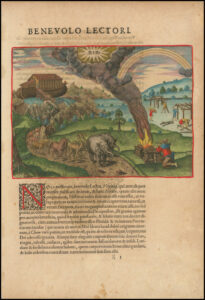
Rare Original 16th Century Engraving of Noah’s Arc By Theodor de Bry
Rare Original 16th Century Engraving of Noah’s Arc By Theodor de Bry
CC-0461 – Rare Original 16th Century Engraving of Noah’s Arc By Theodor de Bry
Cartographer: Theodor de Bry
Published: 1591
Dimensions: 9-1/2″ W x 14″ H
Condition: Preservation is overall very good considering the document is over 400 years old. Paper shows typical signs of age with a small stain at the bottom center on the front. Coloring is original and in good condition.
Description: Theodor de Bry (1528-1598) was a prominent Flemis h engraver and publisher best known for his engravings of the New World. Born in Liege, de Bry hailed from the portion of Flanders then controlled by Spain. The de Brys were a family of jewelers and engravers, and young Theodor was trained in those artisanal trades.
h engraver and publisher best known for his engravings of the New World. Born in Liege, de Bry hailed from the portion of Flanders then controlled by Spain. The de Brys were a family of jewelers and engravers, and young Theodor was trained in those artisanal trades.
As a Lutheran, however, his life and livelihood were threatened when the Spanish Inquisition cracked down on non-Catholics. De Bry was banished and his goods seized in 1570. He fled to Strasbourg, where he studied under the Huguenot engraver Etienne Delaune. He also traveled to Antwerp, London, and Frankfurt, where he settled with his family.
In 1590, de Bry began to publish his Les Grands Voyages, which would eventually stretch to thirty volumes released by de Bry and his two sons. The volumes contained not only important engraved images of the New World, the first many had seen of the geographic novelties, but also several important maps. He also published a collection focused on India Orientalis. Les Grands Voyages was published in German, Latin, French, and English, extending de Bry’s fame and his view of the New World.
This amazing illustration is a beautiful hand colored rendition of Noah’s arc from the Book of Genesis in the Old Testament (Genesis chapters 6:9 – 9:29). The scene depicts the animals leaving the ark as Noah offers a sacrifice to God on an alter and a pillar of smoke that has a sunburst at the top with the Hebrew text that reads “Yahweh“. You can also see a rainbow, which represents God’s promise to never flood the Earth again and Noah’s sons building shelters in the background.
According to Google Translate, the approximate translation of the Classical Latin text below the image reads:
“Dear Reader“
“Do not be afraid, kind reader, of Virginia, where some time ago we made a state, and of Florida, which we now propose to you, that you should conceive for us the history, so that we may derive pleasure from reading and observing them; but, that we may confess the truth, it may greatly affect our hearts also: rather, that we may offer ourselves to him, and marvel at the works of God, that we may freely do to him for the benefit we have received, which he has deigned to reveal to us, and to teach us the way of refuge, when we notice the wonderful things of Florida and its neighbors the inhabitants of the provinces (who, however, no doubt derived their origin from one of Noah’s children, but rather from Ham, as may be believed, than from any of the rest) were so utterly ignorant of the knowledge of God. In any case, they are gifted with an elegant physique, large, robust, daring, agile, but odorous, evasive and treacherous. They have a lurid and dirty color, which they contract by anointing the body with some kind of oil, and by the heat of the sun: for the newly born are white by fate.”
On the reverse of the page, the approximate translation of the Classical Latin text reads:
“Preface to the Reader”
“As indeed I have made the history of Virginia, from whom I had received those icons, I have also brought it to be made for you, I have received this history and its icons in English from the widow of Jacques le Moyne, to whom he was otherwise surnamed de Morgues, a painter who accompanied the Laudonnières (René Goulaine de Laudonnière) on a fruitful voyage into that province, and painted some icons, and then painted the history of the gift, which he showed me several times while he was alive.
I was therefore very glad that I had indeed borne it, spared no expense to commission it for printing, and I and my children spent careful work in cutting the icons on the brass plates, so that they might be more polished, although not very durable, because that finer wood is easily rubbed. Amen, by my diligence I had accomplished nothing, for I had received all things in different parts, and I had been assisted by the benevolent works of my noble friend, in distributing things in order: for he had refined the French of History, and then made it Latin, just as before the History of Virginia.
Therefore, the Choreography of the Province, the icons of the Inhabitants, the manner of life and the rites, should be brought to life, and offered to you, so that you may be able to contemplate them no less comfortably than if you were born in the Province; I also hope for the future, nodding to God, that you may take the meal.” “Exam”
In stock
$2,500.00

